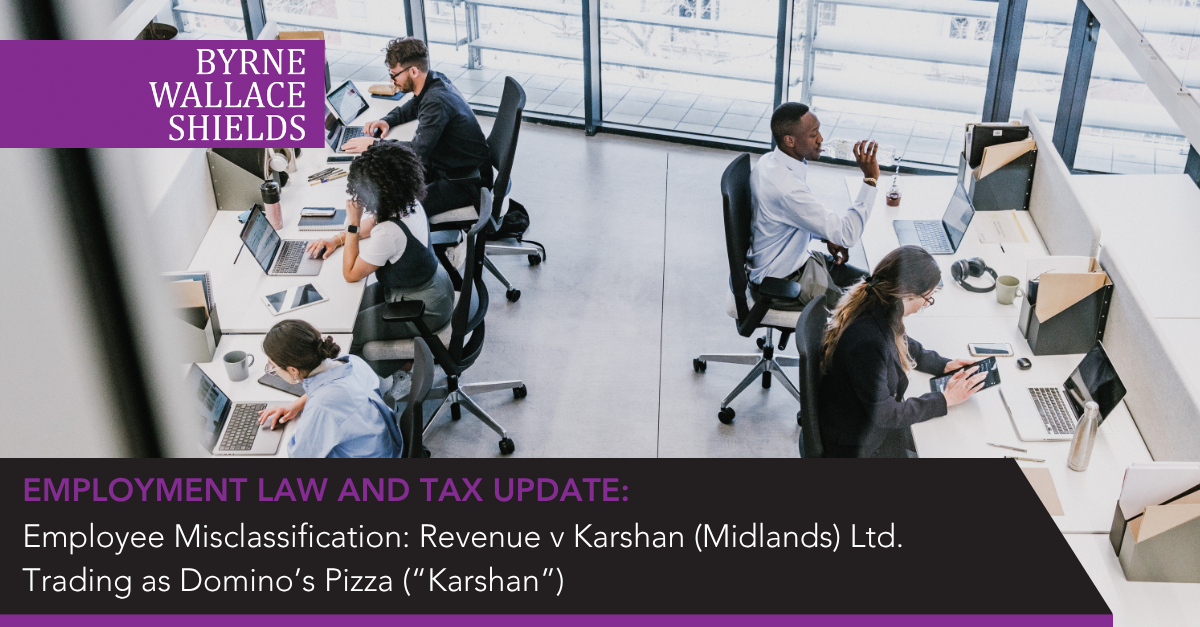Employee Misclassification: Revenue v Karshan (Midlands) Ltd. Trading as Domino’s Pizza (“Karshan”)
Friday, 10 January 2025
Background
On 11 September 2025 Revenue released new guidance which sets out how to correct any payroll tax issues resulting from employees who are misclassified as self-employed persons, in respect of 2024 and 2025 only. Employers have until 30 January 2026 to avail of the correction opportunity in respect of bona fide classification errors recorded in the two years.
Since the ruling in Karshan, Revenue say that it has become apparent that some employers may have misclassified employees, in good faith, as independent contractors and are struggling to make the appropriate corrections now. In recognition of this, Revenue is giving employers a window of opportunity to submit corrective disclosures, amending any payroll errors, by 30 January 2026.
Benefits of making a disclosure
- Disclosures made shall not be subject to penalties or interest. Liabilities settled by way of a phased payment arrangement (“PPA”) will be liable to interest for the repayment period. (The tax arising from this disclosure will be treated as a “technical adjustment” as set out in the Revenue’s Code of Practice for Revenue Compliance Interventions. This means that a tax-geared penalty shall not apply. Furthermore, fixed penalties will not apply.)
- Credit will be available to individuals who have already filed their 2024 returns and paid tax accordingly.
- While the employer must ensure that the full liability to PRSI (both employee and employer) for both years is paid and PRSI records are created for each employee, income tax can be calculated at 20% on the gross amount paid to the employee for each year, even if the 40% rate would normally apply.
- USC must be calculated based on a blended rate of 3.5% of the gross amount paid, even if higher rates would normally apply.
In what circumstances are these benefits not available?
The above mentioned favourable settlement terms will not apply to any individual who, under the Code of Practice on Determining Employment Status in effect prior to October 2023, should have been classified as an employee, or, who should have been classified as an employee based on any published decision or determination of the Department of Social Protection, the Workplace Relations Commission, the Tax Appeals Commission or a court. Also, where Revenue is of the opinion that misclassification is a result of careless or deliberate behaviour, it will result in full liability to Income Tax, USC and PRSI, as well as interest and penalties.
Submission of Disclosure Settlements
- All disclosures are to be submitted to Revenue no later than 30 January 2026.
- Employers availing of this settlement opportunity should advise employees not to declare income which is included in this disclosure when filing their income tax returns for 2024 and 2025.
- Class S PRSI should also not be paid in respect of this income to avoid a situation where the income is taxed twice. The relevant individual should continue to declare income and gains arising from any other sources in either of these years in the usual manner.
Employment risks of misclassification
An individual classified as an employee is entitled to a wide range of statutory protections whereas an independent contractor is not. When an individual is misclassified, the employer can be found to have unlawfully denied these entitlements which may result in significant legal and financial consequences for an employer. A uniform approach is generally taken in respect of classification for both tax and employment law. The application of the five-stage test from the Karshan ruling can be seen in the recent WRC case of Matthew McGranaghan v MEPC Music Limited (ADJ-00037668). The Complainant, a fiddle player, had played in a band since 2014 and on being informed that their services were no longer required, raised a complaint with the WRC for unfair dismissal as an employee amongst other things. After consideration of the caselaw, the Adjudicator found the Complainant to be an employee, ultimately awarding him €43,840 in respect of his employment claims.
As reclassifying contractors as employees may have serious employment law implications for employers, we recommend that a comprehensive workforce assessment is conducted.
Complex issues need to be given careful consideration, such as the treatment of contractors who have already left, headcount restrictions if categorisation of contractors is changed, whether new employment contracts will be issued to those newly categorised employees, what length of continuous service will be noted in such contracts and the statutory employment rights of such newly categorised employees in respect of annual leave, sick pay, minimum wage, pension auto enrolment and working time rules, for example.
It is clear from the 2025 Guidance that the Revenue will take a very strict view of any misclassification after the 30 January 2026 deadline, so it is in the interest of all employers to prioritise this issue and complete a comprehensive assessment of their workforce a soon as possible, considering both tax and employment law implications of any employees who may be misclassified as contractors.
If you are seeking advice on whether you need to make a disclosure or calculate any settlement under the new Guidance and how to do so, please contact the Employment and Taxation Departments at Byrne Wallace Shields LLP for assistance.

